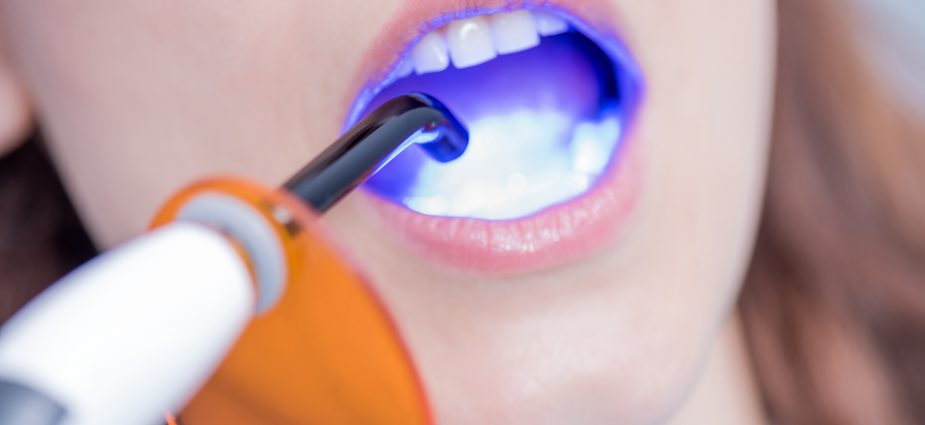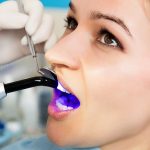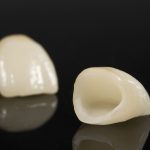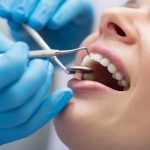Dental Bonding
Medically Reviewed by: Robert E. Steinberger, DDS

On this page: Direct bonding | Adhesive bonding | Procedure details | Consultation | After care | Cost
The term bonding is used in dentistry to describe permanently attaching dental materials to your teeth using dental adhesives and a high intensity curing light.
Whether you realize it or not, you’ve probably received a dental treatment involving either form of dental bonding: direct composite or adhesive bonding of a restoration (crown, bridge, porcelain veneer, inlay/onlay) that was created in a laboratory or in-office.
Direct Composite Bonding
Dentists use tooth-colored composites (white or natural-looking materials) that they have in their offices to fill cavities, repair chips or cracks, close gaps between your teeth and build up the worn-down edges of teeth. Dentists place the materials in or on the teeth where needed.
Because direct composite bonding involves the precise placement of restorative material by the dentist, the direct composite bonding procedure usually is completed in one dental visit. More complicated or extensive treatments may require additional visits. However, there is usually no need for temporaries or waiting days or weeks for laboratory restorations.
The same composite materials also may be directly applied and sculpted to the surfaces of teeth that show most prominently when you smile, for minimally invasive smile makeovers. While dentists call them direct composite veneers, many people just refer to them generically as “bonding.” Composite bonding usually is an ideal and less expensive solution than crowns or veneers for people with chips, gaps between the teeth, staining and discoloration, slight crookedness and misshapen teeth.
Although direct composite veneers typically require minimal preparations, no mold-taking and no temporaries, the artistic skill and precision of the dentist you choose will determine the exact manner in which your direct composite veneers are created. For example, some dentists use putty stents based on an impression of the patient’s teeth and a model of their desired smile to guide them when placing the composite. This helps ensure a satisfactory result.
Adhesive Bonding
Adhesive bonding refers to attaching a restoration to a tooth using an etchant, a bonding agent, an adhesive and a high intensity curing light. This method is typically used for esthetic and metal-free crowns, porcelain veneers, bridges, inlays/onlays and fillings.
The Procedure
Whether your treatment plan calls for direct composite restorations or adhesively bonded restorations, dentists start the process by using a rubber dam to isolate the teeth, to prevent interference from moisture. Depending on the extent of the treatment, anesthetic injections may be required.
Your dentist would then apply a gentle phosphoric acid solution to the surface of the natural tooth, which won’t hurt. Similar to how roughing up a surface with sandpaper can help paint adhere to it better, acid etching of the tooth surface strengthens the bond of the composite and the adhesive. After 15 seconds the phosphoric acid is removed, and a liquid bonding agent is applied.
For a direct composite restoration:
- Your dentist then will place a putty-like composite resin in stages on the natural surface of the tooth, then shape and sculpt it.
- A high intensity curing light will be used to harden that layer of composite, and the previous step will be repeated, then cured, until the filling or direct composite veneer has reached its final shape.
- Your dentist also will create an appropriate finish to ensure that the bonded resin does not dislodge or cause tooth sensitivity and feels and looks smooth.
For a restoration from a laboratory:
- Your dentist will place the appropriate adhesive into the restoration, seat the restoration on the tooth and light-cure it using a high intensity curing light for the appropriate amount of time.
It is common for a bonded tooth – particularly one that has been filled or on which a crown or inlay/onlay has been placed – to feel sensitive after treatment. This minor sensitivity is often short-lived, but if it persists, see your dentist.
Consultation and Treatment Planning
To determine if your dental problems can be solved with direct composite bonding, your dentist first will conduct a thorough examination and evaluation of your teeth and gums. This includes taking and reviewing X-rays of your teeth to fully evaluate candidacy. During your consultation, your dentist will discuss the clinical and cosmetic problems that direct composite bonding can resolve, such as cavities, chips, cracks, fractures, gaps and spaces between teeth, and tooth discoloration. However, if you have teeth that are extensively damaged or your dentist feels other dental issues may affect the success and longevity of direct composite bonding treatment, other options may be presented to you, such as crowns or veneers.
Pre-treatment teeth whitening may be suggested in order to better match the color of the composite restoration to your natural teeth. If whitening is needed, your dentist may wait anywhere from 14 to 21 days before placing your direct composite restorations to ensure a proper and durable bond to your natural tooth structure.
In instances where bonding materials will be used to lengthen or change the shape of your teeth and alter the appearance of your smile, your dentist may take impressions of your teeth before treatment to create a preview model of what your new smile could look like. If you agree with the proposed changes, your dentist may then use this model as a guide or template when placing the direct composite on your teeth.
After Care
Direct composite bonding restorations can provide you with a healthy and beautiful smile for many years, but it is important to follow your dentist’s recommendations for proper oral hygiene, as well as avoid habits that could damage your restorations.
Brush at least twice a day, floss once a day and schedule regular visits to your dentist and hygienist for routine examinations and cleanings.
Refrain from habits such as biting your fingernails and chewing on pens, ice or other hard objects, since direct composite bonding materials are prone to chipping. Your dentist also will suggest you return to the office if you notice any sharp edges on the bonded tooth or teeth, or if the tooth feels differently when you bite down.
Costs
It is difficult to estimate the cost of bonding because the term refers to two procedures commonplace in dentistry and performed in conjunction with other treatments.
For example, someone who needs a metal-free crown from a laboratory will not be charged a separate bonding fee in order to have the crown adhesively bonded into place. Whatever the charge is for that procedure is absorbed into the fee for the crown itself.
However, the fee for treatments such as direct composite veneers, which are typically elective (and cosmetic) in nature, may be more varied, as it is based on factors such as the dentist’s reputation, geographic location, experience and advanced training. Bonding averages between $400 and $2,000 per tooth.
In addition, if the treatment involves composite fillings, for example, then out-of-pocket expenses will be affected by what the dentist charges you, the type of dental insurance you have (dental insurance may pay for a portion of the dental filling) and how much your dental insurance reimburses you for the procedure.
[updated March 28, 2019]
About the Reviewer
 Dr. Robert Steinberger is a top New York dentist with more than 29-years’ experience performing general, cosmetic and reconstructive dentistry services in The Bronx, New York. Dr. Steinberger received his dental degree from the prestigious NYU Dental School before completing his general practice residency at Maimonides Medical Center in Brooklyn. With his highly experienced team at East Tremont Dental, Dr. Steinberger caters to a full range of oral health and dental issues, offering patients the highest standard of dental care, ensuring that each and every one achieves and maintains optimal oral health.
Dr. Robert Steinberger is a top New York dentist with more than 29-years’ experience performing general, cosmetic and reconstructive dentistry services in The Bronx, New York. Dr. Steinberger received his dental degree from the prestigious NYU Dental School before completing his general practice residency at Maimonides Medical Center in Brooklyn. With his highly experienced team at East Tremont Dental, Dr. Steinberger caters to a full range of oral health and dental issues, offering patients the highest standard of dental care, ensuring that each and every one achieves and maintains optimal oral health.






